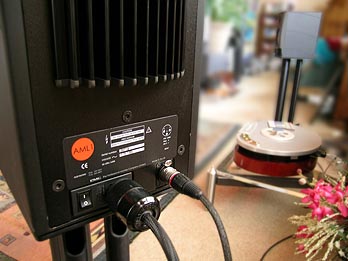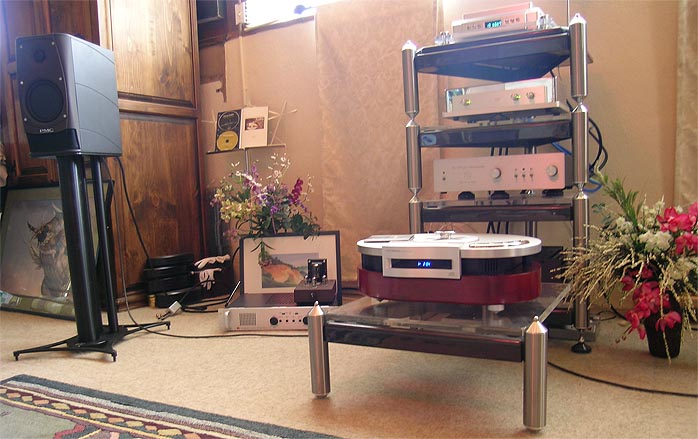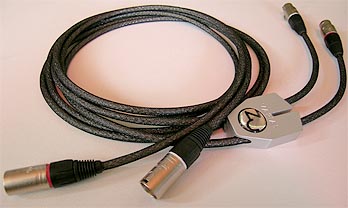|
|
|
|
|
This review page is supported in part by the sponsor whose ad is displayed above
|
|
 |
|
Let's get the bad handled first. It's the obvious Achilles heel here. This speaker is expensive. Ouch! There's the Euro/dollar conversion. There's licensing fees to Bryston for the amps and active crossovers. There's custom drivers not in wide circulation. There's overseas shipping and post-9/11 customs. There's a smaller firm not operating with the same scale of economics as, say, Canadian power house Paradigm. Still, 8500 clams for what you're buying is a lot of bread. It puts the AML1 into the JMlab Mini Utopia leagues. Unlike domesticated über monitors, the PMC monitor never got the trick cosmetic fashion makeover. The brass never anticipated home user interest. Availability now, to US punters more than six years after introduction on British soil to the professional market, is nothing more than a heady experiment spearheaded by Richard Colburn's championship.
It's really his enthusiasm for the package and the current retail climate favoring small monitors on stands that - er, power this development. It'll be no hair off PMC's hide if consumers don't cotton to the concept. It is a pro speaker after all. It successfully continues selling as such. Should the occasional consumer get in on the quiet hoopla, it'll merely be gravy for the manufacturer. That's why the Brits don't apologize for -- or seem much concerned over -- the radical pricing. [Incidentally, PMC UK distributes Yamaha's Flying Mole digital amplifiers for Great Britain's pro sector. "Activating" their small monitors with the moles as is presently optional with Bryston plate amps is planned. This won't include an active crossover. It'll merely be driving passive speakers with internalized amps; not "fully active" but "activated". If done for the AML1, flying molestation could knock the current price down significantly. Of course, performance without the active crossover wouldn't be the same, either.]
|
|
 |
|
|
Now that I've opined why the AML1 won't sell to hobbyists, let me stress why it should - sell. I've already profiled the kind of customer who would get it. Let's get to what she'd get: a very balanced, linear, highly dynamic front-row sound of superior articulation, exceptionally fine detail and no artistic or interpretative liberties. These petite monitors can boogie like demons i.e. very loud without compression; are completely non-fatiguing without editorializing; expectedly image like bandits; and whip out Nils Lofgren-type aggressive slap bass to defy all rhyme or reason if you're coming from passive consumer models and big speakers in general. Have you listened to top-o'-the-heap Dynaudio monitors powered by Musical Fidelity or equivalent kilowatt power? Then you'd know exactly what to expect. It's a no-muss no-fuss honest sound without any sex that doesn't happen to be on the recording.
As a recording monitoring tool, the AML1 doesn't come in any flavor. I'll bet it sounds as neutral and linear as the biggest PMCs and will play as loud if used in the relative nearfield rather than the huge soundstages you'd find at Lucas Film or Teldec. In a standard-sized listening room of 14' x 20', the li'l AML1 will do 30Hz flat to reproduce the lowest open string of an electric bass without any softening, blunting or loss of proper amplitude. That -- and the superior resolving power as a function of precision, articulation and clear absence of mud and soft focus -- will be the two attributes most shocking to audiophiles unfamiliar with top professional active monitors. Things are rock-solid and stable without drift or halos. They dynamically track without any apparent lag. They aren't lean, bleached, zippy or obnoxious at all.
Lack of flavor makes for a just-the-facts-ma'm presentation close to the apparent stage with its lack of ambient soundfield softening. Things are neither bright/forward nor recessed/laid-back but simply direct by being stripped of fine veils with their blurring or romanticizing aspects. The effect is very similar to how current-drive as implemented by Nelson Pass of FirstWatt takes control of the infamous load presented by the AKG K-1000 earspeakers. It's about connecting drivers and amplifiers without intermediate buffers while optimally matching the interface. It would be lazy convenience to put it in those terms -- after all, we know it's an active system -- were it not patently audible. I heard the same traits with the Overkill Audio bi-amplified DSP-networked Encore system. It's an old hat to any mastering engineer of course who, en riposte, would have to wonder: What it is that us audiophiles normally listen to?
Flat, cut-out, in-yer-face, sharp or aggressive are not terms you'd use to peg the AML1. That's not to say that professional monitors with such attributes don't exist. The PMC simply isn't one of them. Neither does it do anything extra such as excessive air, a contoured presence region or highlighted transients. It's supposed to be an honest portal through which to observe music with a microscope and detect the tiniest flaw in a mix. Therein lies a potential rub. A mastering engineer gets paid to remain firmly planted in the moment. He makes critical decisions that affect high-profile acts and sales charts. He isn't paid to go off on mental or emotional escapades while listening to what comes out of his speakers. The endless choices in HighEnd audio all reflect the fact that many pleasure listeners do in fact very much expect to get carried away. Like Arnold Schwarzenegger in Total Recall's first visit to the corporative offices, they get to pick particular attributes that will help make their musical vacation most memorable. If that means emphasizing visual aspects, sculpting the midrange, fattening up tone, creating excess soundstage depth... so be it.
|
|
|
| Most music lovers aren't truth seekers. Neither do they all subscribe to the notion of The Absolute Sound, sitting first row balcony center in a large concert hall ingesting purely acoustic music. How you feel about the honest directness of the PMCs will depend on your allegiances. This is a very unfussy live sound such as you'd hear being very close to the stage with the artists, with no deep hall effects mixing into the raw signal. Though this little speaker pounds out bass better even than the groundbreaking Platinum Solo of yore, it naturally doesn't move the kind of air four 10-inch woofers per side do. While dynamic scaling remains linear, gut-level instinctual awe, of massively displaced low-frequency air waves, is lacking. It's so obvious as to seem a terribly redundant explanation for a 6.5" 2-way with a 1.4kHz crossover point (except for how prodigiously low it does go). You get extension and pitch definition from direct drive and you get |
|
 |
|
relative tonal density that results from proper foundation presence. You won't get the ultimate weight of blown-wide-open scale that dynamic line sources dispatch by virtue of sheer surface area. No taiko drum pressure differentials here.
For the money charged, the air-moving capabilities of the AML1 limited by Physics could be its biggest liability. A big VMPS would make that point in a hurry. The flip side of that equation is turn-key optimization. The PMC has just the right amount and kind of amplifier wattage. You're buying neither too little nor too much nor the wrong damping factor. Go passive and it's all a crap shoot. Plus, the AML1 is small enough to be thrown into the Subaru to get set up in a vacation rental or be loaned to your kid throwing a party in his dorm. The Ferrari Enzo moniker of Mr. Colburn is pretty fitting - except that the AML1 looks nothing like a sleek and gleaming Ferrari, Wilson, Kharma or Thiel. It's functional and inoffensive but no bombshell cheerleader to most high-enders playing in these leagues.
It's purely down to big performance in a tiny integrated package. And big performance is putting it mildly. The soundstage is plain huge. Because LF pedals and walking bass lines aren't just good for the size but good, period, this stage isn't merely sizeable as airy cubits filled with sunlight. It's sizeable as in fullness, substance and meat. Things growl with menace, go pop, crack and snap just as sharply and shockingly as they do in a club. Again, think Dynaudio with high-power amps. Crank up the wick and everything stays together. Play "Passenger 57" by Stanley & Clark; Brian Bromberg; Keb Mo; Aaron Neville; Boz Skaggs; the Fairfield Four or Christian McBride. The discrepancy of size, between reproducer and what is reproduced, will surprise not just for the image spread (that's expected with monitors) but because of the balls-to-the-wall massiveness and wallop that kick in as the volume rises. This is an unapologetic goose-me speaker!
The treble refuses to get hairy but if a singer shows a bright glint on peaks, you'll hear it just as you would live. Nothing gets smoothed over. Little details like fingers sliding across strings, reed spittle with woodwinds, mechanical key actions on piano and saxes and a singer turning slightly from a microphone or taking a step back are crystal clear. When mixes get complex, the superior resolution and separation power of these monaurally bi-amped minis remain unruffled. It puts a lie to the notion that it takes a 3-way to free up the midrange driver and guarantee vocal clarity when the heavy artillery starts to fire down low. HipHoppers can slam away and even dial in a +3dB bass boost at 30Hz which kicks in very gradually with the knee for this lift set at 500Hz. As I said earlier, it's an extremely unfussy setup. It is monitor-accuracy precise but not in how 'philes relate to that genre by way of cheap and notorious precedents. The AML1s are audiophile mastering monitors, period. Simply insert the name of any number of high-profile HiFi makers instead of "audiophile".
|
|
 |
|
|
If nothing else, I'd wish that diehard 'philes and fellow reviewers would hear the AML1 at least once in their lives. You'd learn how the other half lives - the pros who care about music and sound quality at least as much as we do and rely on specialty product for their applications that are every bit as advanced and esoteric as ours. Meridian and Naim market active speakers at our sector. Do they sell as successfully as those firms' electronics? I doubt it, at least for the US. Paradigm's Active 40 was arguably their best and most advanced model then. But it was also well ahead of its time and thus doomed. Though a veritable old timer when viewed against the 9-month product cycles of big loudspeaker houses today, the PMC AML1 is likely too alien and 'fixed' a concept for most audiophiles still. It remains outside of its time, a three-legged Siamese.
On the other hand, NHT's new DSP-corrected active three-piece system proves that other engineering-centric companies believe as well that the time is ripe to revisit this concept for home-based listeners. Were it not for their excessive price, the AML1 would warrant a blanket recommendation for the kind of audiophile who values the charge and excitement of a live club performance over the tamer, fluffier, ambient-enhanced (diluted?) playback experience many home listeners design for themselves. Alas, now that affordable 'digital' amps from Hypex, Yamaha and B&O lend themselves for cost-efficient active speakers, the AML1 is unconscientiously expensive. Make no mistake - it's an awfully impressive technical, packaging and performance achievement. But at its present retail, it's priced too upscale for the realistic rather than dream target customer and not spiffed up enough to compete with other $10K monitor offerings that actually find an audience in decorated homes. (While this particularly fancy $1,700/pr stand is optional, some type of proper support is mandatory. At $500/pr minimum for a decent stand, we're still talking at least $9K for the package - like my Zu Definitions with their four self-powered 10" woofers and 101dB sensitivity for the passive array).
|
|
|
|
Still, this feisty speaker could put a lot of audiophiles out of their professional misery. Mind you, I'm one of those very audiophiles myself. Take no offense. Simply recognize that our kind has a nearly professional (manic) interest in changes, upgrades, tweaks and sonic experiments for the sake of experiments. The AML1 says sayonara to all that madness. In the final analysis, that's the real reason I don't think bona fide audiophiles would ever take it serious. True, the price is a bit prohibitive but that has never yet dissuaded committed 'philes from going after things far more left-field and downright experimental than the AML1. No, most of us are simply not prepared to call it quits and settle down for good with something that's about as non-tweaky and set'n'forget as |
|
|
 |
|
it comes - never mind lacks bragging rights and serious cachet of any sort. The AML1 is a cure for a real disease 'cept we ain't ready to be cured. We'd rather proudly insist on suffering some more for our cause (whatever, exactly, that is except to stay busy). It's what separates us from the pros. They can't afford to suffer while they stay busy working for a living. Too, they require the unvarnished truth. Those of us not Danes -- remember that Dynaudio slogan? -- can tailor things for a personally pleasing or compelling version of the truth. Nothing wrong with that. I'd be the first one to claim that liberty for myself. After all, the artificial playback experience at home is a co-creative venture. It's not just about hearing it as it is. It's about maximizing our enjoyment thereof, whatever that means to the individual. The AML1's Quad-reminiscent HF/LF tilt controls provide for some of that but can't "spot-check" or notch-filter response as can DEQX for example. Plus, you are stuck as it were with the choice of Bryston amplification.
My newly acquired Zu Cable Definitions driven from the 8wpc Canary Audio 300B monos give me a slightly softer, warmer and more illuminated sound that comes alive sooner at low volumes yet doesn't crack quite as hard (for that, insert the FirstWatt F1). However, that combo has more tone, moves far more air -- especially impressive when large drums get going -- and creates that subconscious "yeah" reaction that might elude another listener wired differently altogether. This reaction goes deeper yet with the AudioSector Patek amps at the helm that combine valve-type image density with the edge articulation of transistors. Mind you, the AML1 doesn't create any cognitive dissonance when you close your eyes except moves you close to the stage. CD arises when you open your eyes. Still and on a purely personal level -- and I wager a guess that it's the Bryston sound -- the PMC monitor doesn't hit my "positive panic" lust button. Would you believe it if I told you that it sounds a bit too uncolored or perhaps flat to me? Not clinical or sterile, mind you, simply a bit dry. However, if it's really the truth you're after -- not what you'd like it to be but what it is as per the actual recording -- I dare predict the AML1 would pass muster with the toughest jury: the guys who were there when the record was cut. Include into that jury listeners who attend plenty of club performances rather than the somewhat idealized mirror images we tend to erect for in-home consumption.
|
|
| If you don't like this jury's verdict, the AML1s don't care. They have won before the hearing ever started. They do exactly what its engineers claimed they would do: pretty much nothing. The AML1 offers a tremendous amount of nothing -- arguably a very close speaker equivalent to the straight-wire-with-gain amplifier ideal -- for a very steep price, in a honey-I-shrunk-my-statements package. That makes it a pretty uncommon offering for our market. If I were to retire from the hobby and do music listening without any concern for what our kind obsesses over; if my attention was as focused on some other gig, endeavor or calling that consumed my working day hours as does my present 6moons gig; I'd seriously look into this class of active monitor speaker. It could well be the most practical appliance-like solution for the task. In fact, if my lifestyle was such as to include vacation homes, I might do it right now. I'd feel assured of reliability and inconspicuousness while being up to the impromptu task of driving a wild party into the wee hours of the morning even if I hadn't played the system for 9 months prior and only visited my cabin or |
|
|
|
|
 |
|
| cottage 2 weeks out of the year. There's a lot to be said for that kind of maintenance-free simplicity where you simply hit 'power' and 'play' and forget about all the rest of it. Best of all? These speakers completely belie their stature not just in the vast casting of images but in their power handling and prodigious bass extension. From that perspective alone, they're a major trip. If you consider PMC's pro clients -- their website will get you started -- they clearly enjoy a very high-end reputation in their sector. Should the expense not scare you away and the whole notion of a race-track-ready aural coupe hit all your hot buttons, the AML1s could indeed be as unique and unmatched as Richard Colburn believes them to be. Just think Mini Cooper, not Ferrari. |
|
|
|
|
|
 |
|
|
 |
|
 |
|
|
|
|
|
|
 |
|
|
|
|
|
|
|
|
|
|
|
|
|
|
|